Interface Characteristics of Ti-Clad V–4Cr–4Ti Alloy Diffusion-Bonded Joint Produced by Hot Forging
Abstract
:1. Introduction
2. Materials and Methods
3. Results and Discussion
4. Conclusions
- (1)
- A sound diffusion-bonded interface was obtained. The interface was about 100 μm in width and can be divided into two different zones in which zone I is the Widmanstatten structure consisting of an α-Ti phase and β-Ti phase and zone II—adjacent to V–4Cr–4Ti substrate—is the single β-Ti phase band structure.
- (2)
- A maximum micro-hardness value of 332 HV was measured at the transitional region between the Ti substrate and the V–4Cr–4Ti/Ti joint while the minimum level of hardness reaching only 182 HV was located in a region in the V–4Cr–4Ti substrate adjacent to the joint. The average hardness of the Ti substrate and the V–4Cr–4Ti alloy are 190 HV and 258 HV, respectively.
- (3)
- The bonding strength of the V–4Cr–4Ti/Ti joint was higher than 165 MPa, according to the results of push-out tests. It was demonstrated that the fracture of the joint took place in the region with the highest hardness, which is probably ascribed to the stress concentration caused by the phase transformation of the Ti substrate during the air cooling process.
Acknowledgments
Author Contributions
Conflicts of Interest
References
- Malang, S.; Leroy, P.; Casini, G.P.; Mattas, R.F. Crucial issues on liquid metal blanket design. Fusion Eng. Des. 1991, 16, 95–109. [Google Scholar] [CrossRef]
- Barleon, L.; Casal, V.; Lenhart, L. MHD flow in liquid-metal-cooled blankets. Fusion Eng. Des. 1991, 14, 401–412. [Google Scholar] [CrossRef]
- Malang, S.; Borgstedt, H.U.; Farnum, E.H.; Natesan, K.; Vitkovski, I.V. Development of insulating coatings for liquid metal blankets. Fusion Eng. Des. 1995, 27, 570–586. [Google Scholar] [CrossRef]
- Muroga, T.; Pint, B.A. Progress in the development of insulator coating for liquid lithium blankets. Fusion Eng. Des. 2010, 85, 1301–1306. [Google Scholar] [CrossRef]
- Pint, B.A.; Devan, J.H.; Distefano, J.R. Temperature limits on the compatibility of insulating ceramics in lithium. J. Nucl. Mater. 2002, 307–311, 1344–1350. [Google Scholar] [CrossRef]
- Hubberstey, P.; Sample, T. Thermodynamics of the interactions between liquid breeders and ceramic coating materials. J. Nucl. Mater. 1997, 248, 140–146. [Google Scholar] [CrossRef]
- Natesan, K.; Reed, C.B.; Rink, D.L.; Haglund, R.C. Development and performance of aluminum nitride insulating coatings for application in a lithium environment. J. Nucl. Mater. 1998, 258–263, 488–494. [Google Scholar] [CrossRef]
- Suzuki, A.; Muroga, T.; Pint, B.A.; Yoneoka, T.; Tanaka, S. Corrosion behaviour of AlN for self-cooled Li/V blanket application. Fusion Eng. Des. 2003, 69, 397–401. [Google Scholar] [CrossRef]
- Smith, D.L.; Konys, J.; Muroga, T.; Evitkhin, V. Development of coatings for fusion power applications. J. Nucl. Mater. 2002, 307–311, 1314–1322. [Google Scholar] [CrossRef]
- Vertkov, A.V.; Evtikhin, V.A.; Lyublinski, I.E. Self-healing electrical insulating coating processes for vanadium alloy–lithium systems. Fusion Eng. Des. 2001, 58–59, 731–735. [Google Scholar] [CrossRef]
- Pint, B.A.; Tortorelli, P.F.; Jankowski, A.; Hayes, J.; Muroga, T.; Suzuki, A.; Yeliseyeva, O.I.; Chernov, V.M. Recent progress in the development of electrically insulating coatings for a liquid lithium blanket. J. Nucl. Mater. 2004, 329–333, 119–124. [Google Scholar] [CrossRef]
- Terai, T.; Suzuki, A.; Yoneoka, T.; Mitsuyama, T. Compatibility of AlN with liquid lithium. J. Nucl. Mater. 2000, 283–287, 1322–1325. [Google Scholar] [CrossRef]
- Vitkovsky, I.V.; Gorunov, A.V.; Engelko, V.I.; Kirillov, I.R. Development and testing of electroinsulating barriers for lithium-vanadium fusion blanket. Fusion Eng. Des. 2002, 61–62, 739–743. [Google Scholar] [CrossRef]
- Pint, B.A.; Moser, J.L.; Jankowski, A.; Hayes, J. Compatibility of multi-layer, electrically insulating coatings for vanadium–lithium blankets. J. Nucl. Mater. 2007, 367–370, 1165–1169. [Google Scholar] [CrossRef]
- Pint, B.A.; Pawel, S.J.; Howell, M.; Moser, J.L.; Garner, G.W.; Santella, M.L.; TortorelliF, P.F.; Wiffen, W.; DiStefano, J.R. Initial characterization of V–4Cr–4Ti and MHD coatings exposed to flowing Li. J. Nucl. Mater. 2009, 386–388, 712–715. [Google Scholar] [CrossRef]
- Chopra, O.K.; Smith, D.L. Corrosion behavior of vanadium alloys in flowing lithium. J. Nucl. Mater. 1988, 155–157, 683–689. [Google Scholar] [CrossRef]
- Evtikhin, V.A.; Lyublinski, I.E.; Pankratov, V.Y. Vanadium alloys as structural materials for liquid lithium blanket of fusion reactors. J. Nucl. Mater. 1992, 191–194, 924–927. [Google Scholar] [CrossRef]
- Yasumoto, T.; Yamakawa, K.; Iwase, N.; Shinosawa, N. Reaction between AlN and Metal Thin Films during High Temperature Annealing. J. Cerem. Soc. Jpn. 1993, 101, 969–973. [Google Scholar] [CrossRef]
- He, X.; Yang, S.; Du, Y.; Tao, K. Reaction layer formation at the interface Ti or Zr and AlN. Phys. Stat. Sol. A 1996, 157, 99–106. [Google Scholar] [CrossRef]
- He, X.; Yang, S.; Tao, K.; Fan, G. Investigation of the interface reactions of Ti thin films with AlN substrate. J. Mater. Res. 1997, 12, 846–851. [Google Scholar] [CrossRef]
- DiStefano, J.R.; DeVan, J.H. Reactions of oxygen with V-Cr-Ti alloys. J. Nucl. Mater. 1997, 249, 150–158. [Google Scholar] [CrossRef]
- Potapenko, M.M.; Drobishev, V.A.; Filkin, V.Y.; Gubkin, I. Manufacture of semifinished items of alloys V-4Ti-4Cr and V-10Ti-5Cr for use as a structural material in fusion application. J. Nucl. Mater. 1996, 233–237, 438–441. [Google Scholar] [CrossRef]
- Bhanumurthy, K.; Kale, G.B. Reactive diffusion between titanium and stainless steel. J. Mater. Sci. Lett. 1993, 12, 1879–1881. [Google Scholar] [CrossRef]
- Kundu, S.; Ghosh, M.; Laik, A.; Bhanumurthy, K.; Kale, G.B.; Chatterjee, S. Diffusion bonding of commercially pure titanium to 304 stainless steel using copper interlayer. Mater. Sci. Eng. A 2005, 407, 154–160. [Google Scholar] [CrossRef]
- Qin, B.; Sheng, G.M.; Huang, J.W.; Zhou, B.; Qiu, S.Y.; Li, C. Phase transformation diffusion bonding of titanium alloy with stainless steel. Mater. Charact. 2006, 56, 32–38. [Google Scholar] [CrossRef]
- Sridhar, G.; Kutumbarao, V.V.; Sarma, D.S. The influence of heat treatment on the structure and properties of a near-α titanium alloy. Metall. Trans. A 1987, 18A, 877–891. [Google Scholar] [CrossRef]
- Gil, F.J.; Ginebra, M.P.; Manero, J.M.; Planell, J.A. Formation of α-Widmanstätten structure: Effects of grain size and cooling rate on the Widmanstätten morphologies and on the mechanical properties in Ti6Al4V alloy. J. Alloys Compd. 2001, 329, 142–152. [Google Scholar] [CrossRef]
- Pelleg, J. Diffusion of 51Cr in vanadium. Philos. Mag. A 1995, 71, 431–439. [Google Scholar] [CrossRef]
- Tsisar, V.; Nagasaka, T.; Flem, M.L.; Yeliseyeva, O.; Konys, J.; Muroga, T. Effect of post-weld heat treatment on microstructure, hardness and low-temperature impact toughness of electron beam welds of NIFS-HEAT-2 and CEA-J57 heats of V–4Ti–4Cr alloy. Nucl. Mater. Energy 2016, 9, 436–440. [Google Scholar] [CrossRef]
- Chennaiah, M.B.; Kumar, P.N.; Rao, K.P. Effect of PWHT on the hardness and fractured microstructure of IS-103Cr1 welded joint. Mater. Today Proc. 2017, 4, 1193–1198. [Google Scholar] [CrossRef]
- Nishimura, A.; Iwahori, A.; Heo, N.J.; Nagasaka, T.; Muroga, T.; Tanaka, S.I. Effect of precipitation and solution behavior of impurities on mechanical properties of low activation vanadium alloy. J. Nucl. Mater. 2004, 329, 438–441. [Google Scholar] [CrossRef]
- Dezellus, O.; Milani, L.; Bosselet, F.; Sacerdote-Peronnet, M.; Rouby, D.; Viala, J.-C. Mechanical testing of titanium/aluminium–silicon interfaces by push-out. J. Mater. Sci. 2008, 43, 1749–1756. [Google Scholar] [CrossRef]
- Seward, G.G.E.; Celotto, S.; Prior, D.J.; Wheeler, J.; Pond, R.C. In situ SEM-EBSD observations of the hcp to bcc phase transformation in commercially pure titanium. Acta Mater. 2004, 52, 821–832. [Google Scholar] [CrossRef]
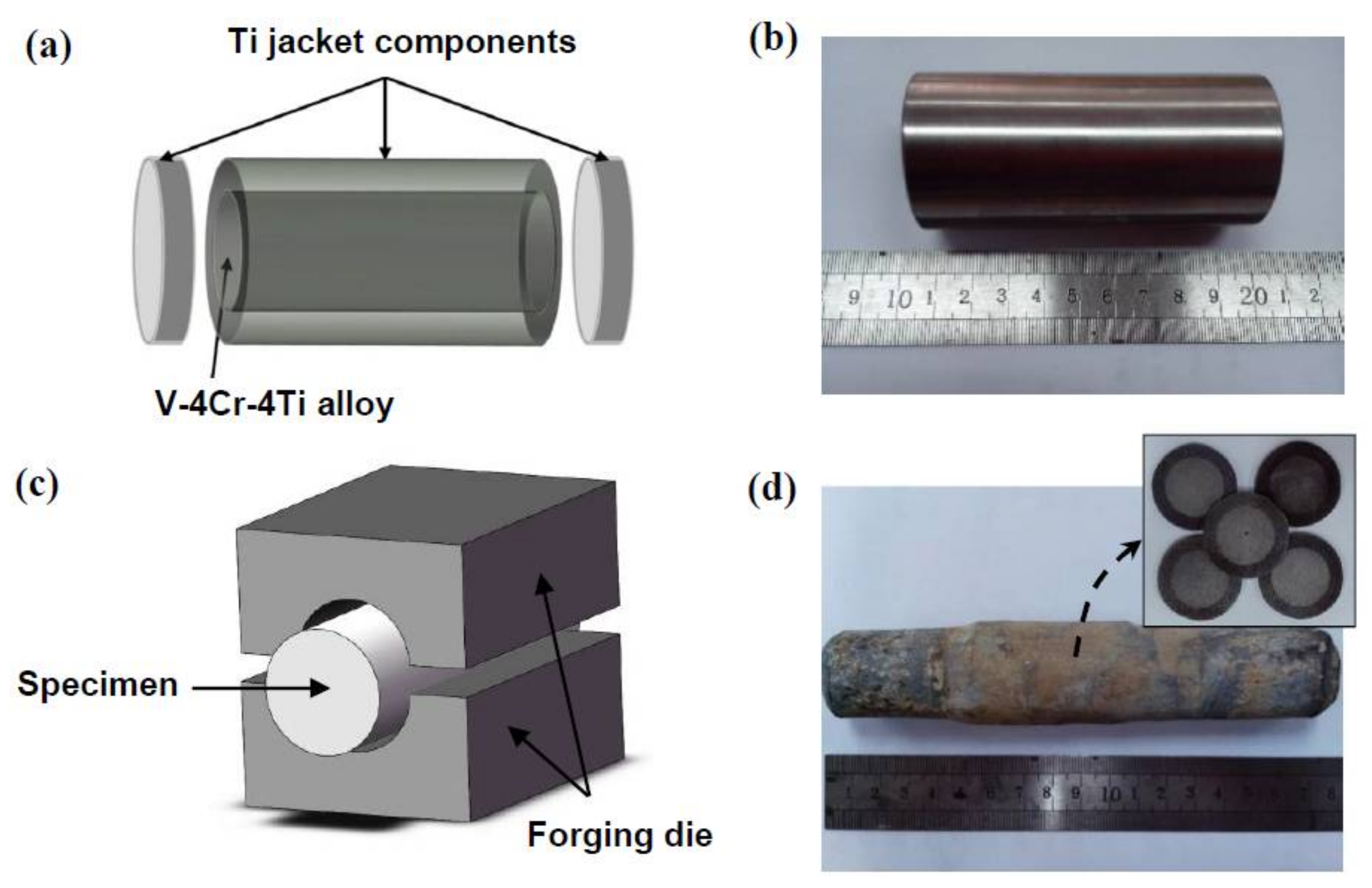
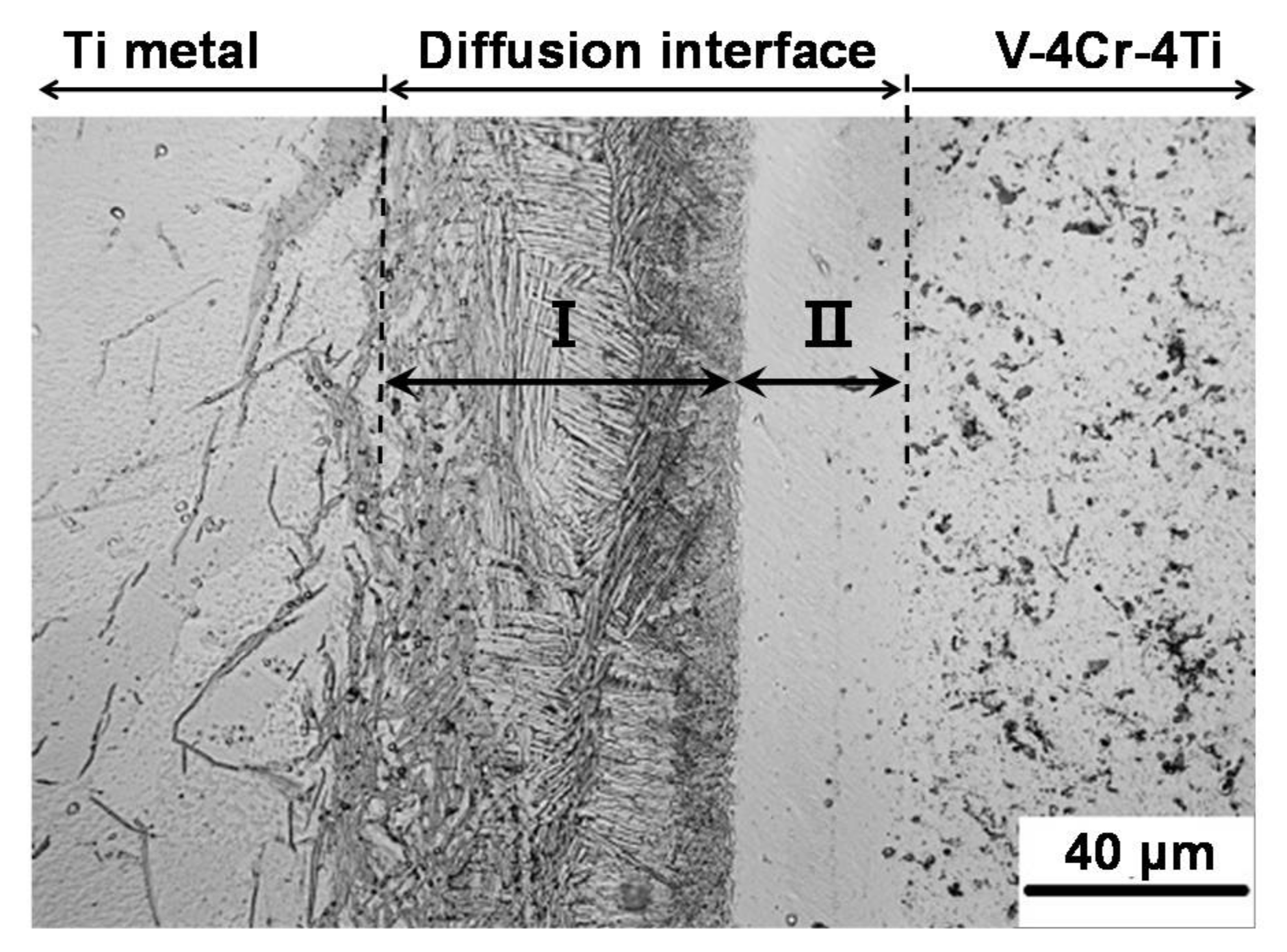
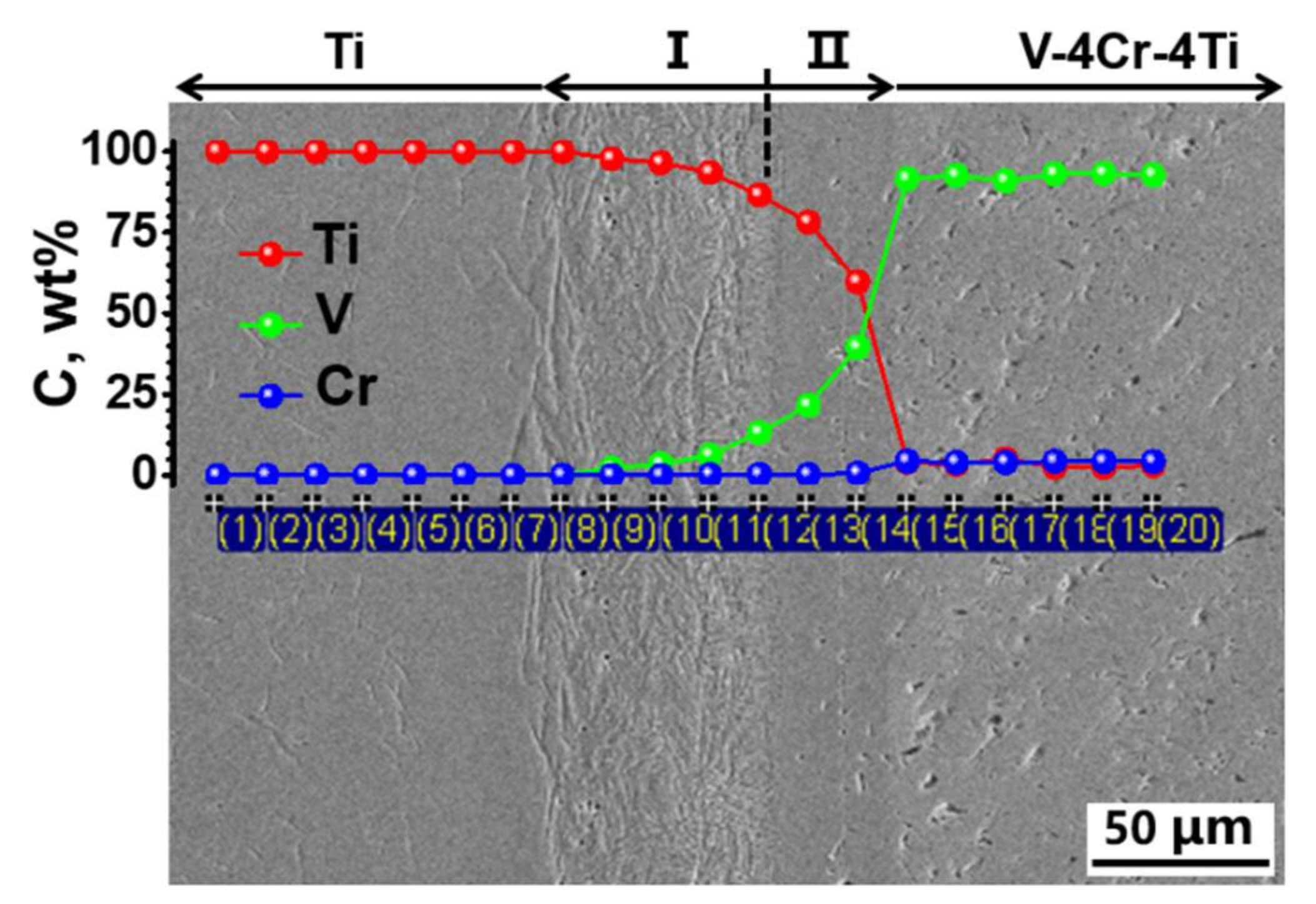
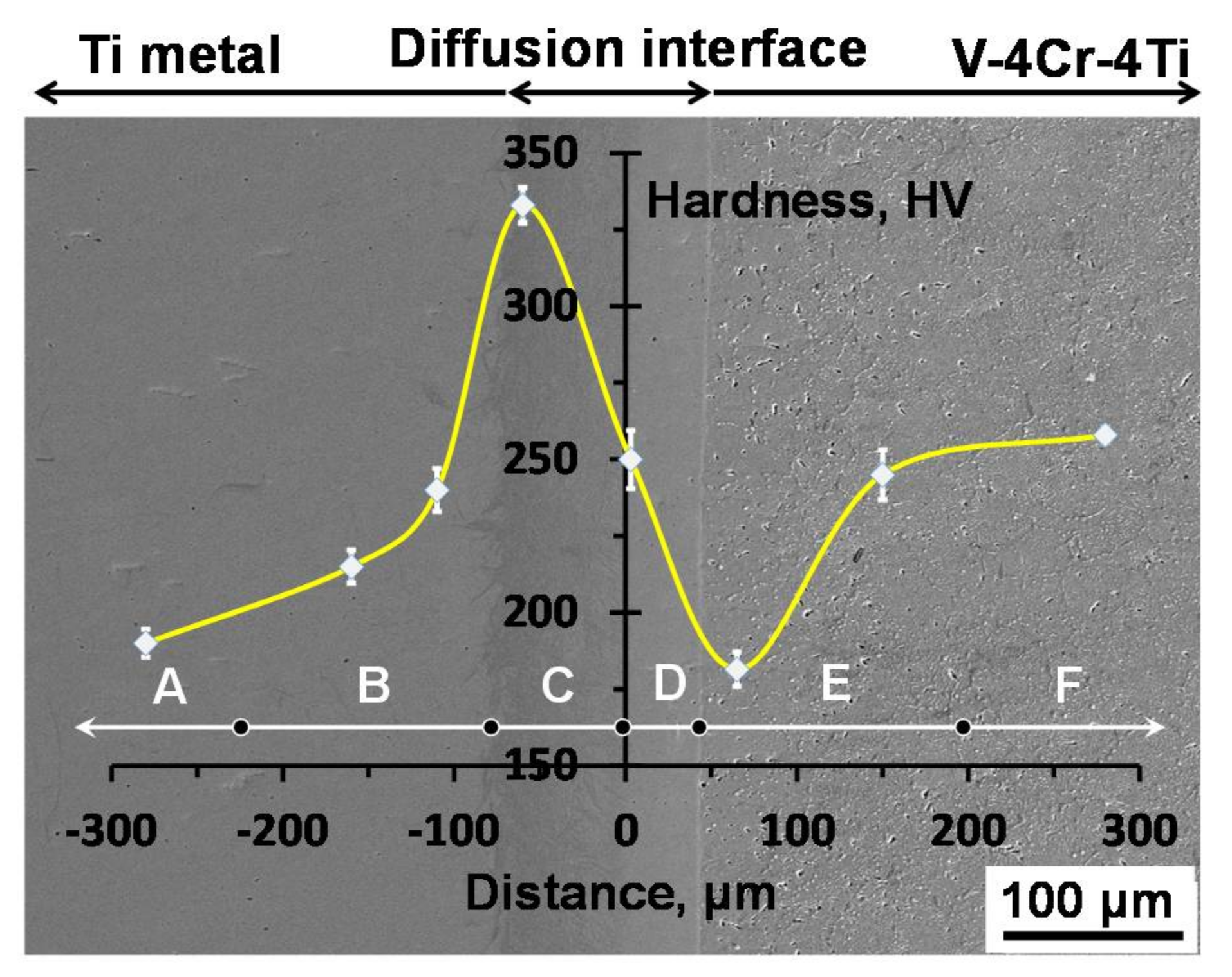

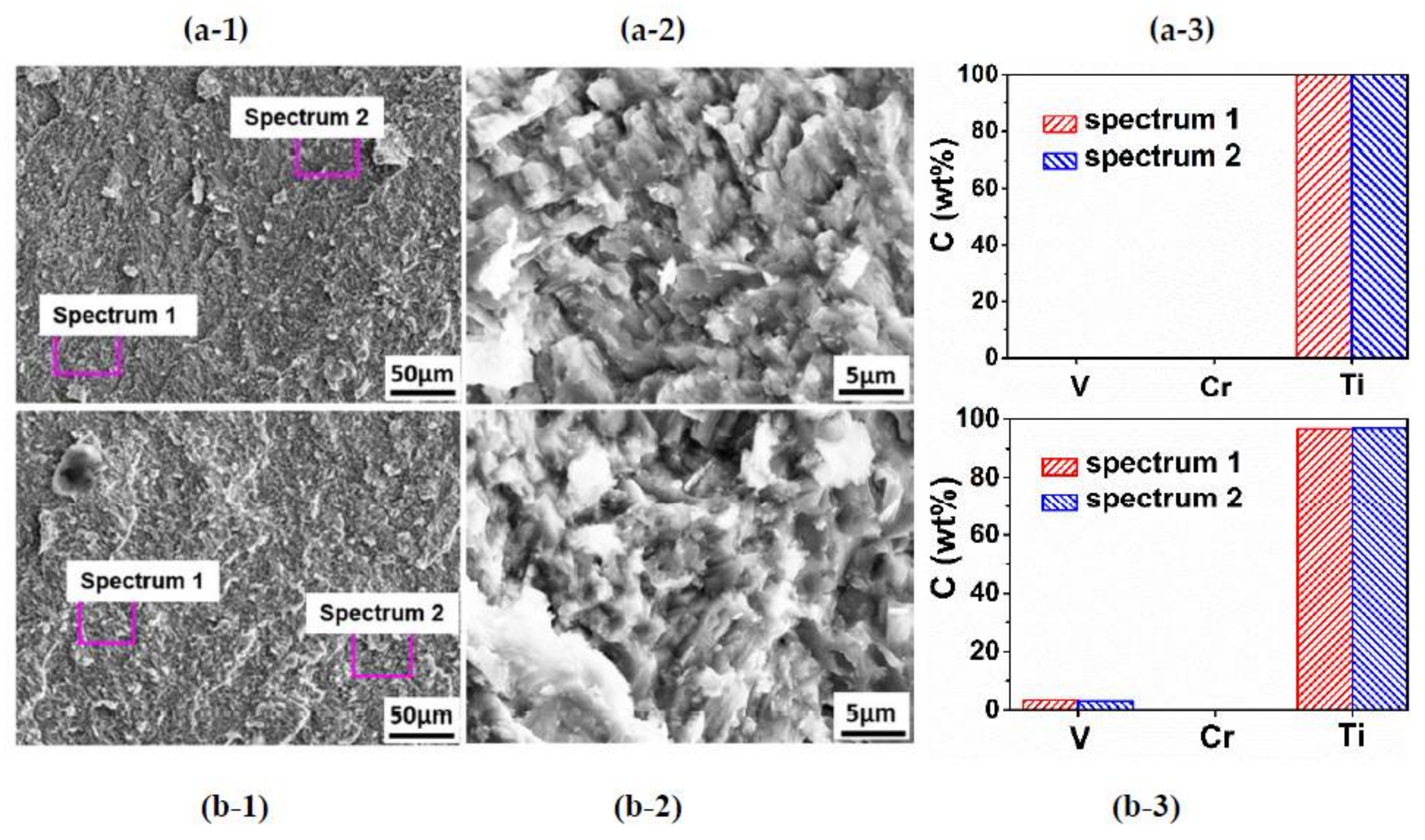
| Material | V | Ti | Cr | Fe | C | N | O |
|---|---|---|---|---|---|---|---|
| V–4Cr–4Ti | Bal. | 3.36 | 3.45 | - | 0.052 | 0.001 | 0.033 |
| Pure Ti | - | Bal. | - | 0.2 | 0.1 | 0.05 | 0.2 |
© 2018 by the authors. Licensee MDPI, Basel, Switzerland. This article is an open access article distributed under the terms and conditions of the Creative Commons Attribution (CC BY) license (http://creativecommons.org/licenses/by/4.0/).
Share and Cite
Zhang, G.; Han, W.; Yi, X.; Wan, F. Interface Characteristics of Ti-Clad V–4Cr–4Ti Alloy Diffusion-Bonded Joint Produced by Hot Forging. Appl. Sci. 2018, 8, 577. https://doi.org/10.3390/app8040577
Zhang G, Han W, Yi X, Wan F. Interface Characteristics of Ti-Clad V–4Cr–4Ti Alloy Diffusion-Bonded Joint Produced by Hot Forging. Applied Sciences. 2018; 8(4):577. https://doi.org/10.3390/app8040577
Chicago/Turabian StyleZhang, Gaowei, Wentuo Han, Xiaoou Yi, and Farong Wan. 2018. "Interface Characteristics of Ti-Clad V–4Cr–4Ti Alloy Diffusion-Bonded Joint Produced by Hot Forging" Applied Sciences 8, no. 4: 577. https://doi.org/10.3390/app8040577





